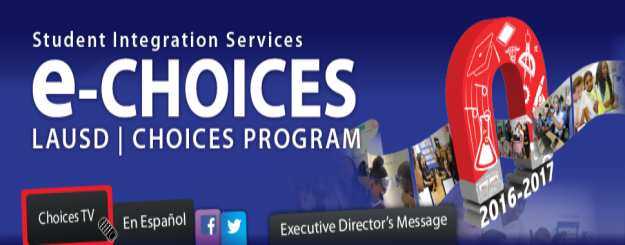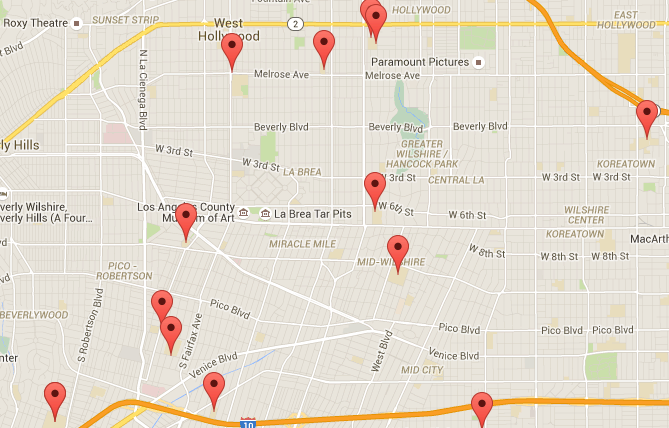Elizabeth Fuller | Larchmont Buzz | http://bit.ly/1Lbu4xC
[Note: This is the first in what will be a multi-part, occasional series about school options in mid-town Los Angeles.]
October 7, 2015 :: Los Angeles residents have a dazzling array of choices when it comes to Kindergarten through 12th grade education.
The five major options are Los Angeles Unified School District (LAUSD) neighborhood schools (the traditional public schools within walking distance of your home), magnet programs (specialty-focused programs open to students district-wide), charters (public schools operated by independent, charter-governed organizations with some degree of LAUSD oversight), private (a.k.a. independent) schools, and homeschooling.
Each of these educational choices has its own application process and, in many cases, a specific application season that differs from the other types of schools.
October is application month for LAUSD magnet programs, with a window that opened on October 1 and will close on November 13…so it’s a good time to shine a light on this particular option.
Magnet programs have their origins in the 1960s and ’70s, when districts were looking for creative options to comply with federal desegregation mandates. Magnet schools feature special curricula, often based on areas of interest, not found at other schools. These programs entice students from all over the city, which ideally results in a more diverse ethnic balance, more accurately reflective of the district’s overall population than schools based solely on residential districts. So magnet programs today still receive special federal funding for their role in a school district’s overall desegregation efforts.
Fittingly, applications for magnet program choices are made exclusively through the district’s eChoices website, which explains everything you need to know about magnet programs in general, which schools host which kinds of specialty programs, how to apply, the lottery system used to allot spaces in the various programs…and the mysterious “points” system that can sound pretty confusing until you get the hang of it.
Briefly, students are selected for magnet programs through lotteries, but their priority in those lotteries is often weighed by a point system. Points are awarded for a variety of factors, according to the following formula:
- - Sibling at the school – 3 points
- - Resident school is overcrowded – 4 points
- - Resident school is Predominantly Hispanic, Black, Asian or Other Non-Anglo (PHBAO)
- - Student is already on a waiting list at a magnet school but has not yet been admitted – 4 points
- - Student is already enrolled in the highest grade at a magnet program (e.g elementary or middle school) – 12 points, good for one year only as the student matriculates into a new school at a higher grade level (e.g. middle or high school)
Students can accumulate up to 12 points, with waiting list points bankable for up to three years (and up to the 12-point maximum). Also, some magnet programs give additional priority based on factors such as a residence near the school (for magnets that were recently converted from neighborhood schools), auditions or portfolios (for performing or fine arts magnets) or special tests or recommendations (for Gifted/Highly Gifted/High Ability magnets).
Magnet schools come in many flavors, most often categorized by a specific field of interest or instructional focus, such as STEM (Science, Technology, Engineering and Math), Environmental Studies, Enriched Studies, Gifted/Highly Gifted/High Ability, Performing Arts, Visual Arts, Foreign Languages, or other specialty.
The other unique thing about magnet programs is that, unlike local neighborhood schools or public charter schools, and because they draw students out of their home districts to schools often much further away, magnets offer free bus transportation to provide equal attendance opportunity for all students. Pickup and drop-off locations are usually at a school close to the student’s home.
Despite the available bus transportation, however, many parents do opt for magnet choices closest to their home neighborhood, to make the commutes as short as possible for their children. So here are the magnet programs most local to our mid-town area. Click on the links to learn more about each of them:
Elementary Schools
Carthay School of Environmental Studies Magnet
Grades 1-5
6351 W. Olympic Blvd., 90048Crescent Heights Language Arts/Social Justice Magnet
Grades 1-5
1661 S. Crescent Heights Blvd., 90035Marvin Avenue Language (Chinese, French, Korean or Spanish) Magnet
Grades 1-5
2411 Marvin Ave, 90016Melrose Avenue Math/Science/Technology Magnet
Grades: K-5
731 N. Detroit St., 90046Mid City’s Prescott School of Enriched Sciences
Grades 1-5
3150 W. Adams Blvd., 90018
Middle Schools
Bancroft Middle School Gifted/Highly Gifted/High Ability STE[a]M Magnet
Grades 6-7
929 N. Las Palmas Ave., 90038Bancroft Middle School Performing Arts Magnet
Grades 6-8
929 N. Las palmas Ave., 90038John Burroughs Gifted/Highly Gifted/High Ability Magnet
Grades 6-8
600 S. McCadden Pl.Joseph LeConte Center for Enriched Studies/Communication Arts Magnet
Grades 6-8
1316 N. Bronson Ave., 90028Joseph LeConte Middle School Health/Engineering/Applied Sciences/Technology Magnet
Grades 6-8
1316 N. Bronson Ave., 90028Virgil Middle School Medical and Health Science Magnet
Grades 6-8
152 N. Vermont Ave., 90004
Middle and High Schools
Los Angeles Center for Enriched Studies (LACES)
Grades 6-12
5931 W. 18th St., 90035
High Schools
Fairfax Magnet Center for Visual Arts
Grades 9-12
7850 Melrose Ave., 90046Hamilton Humanities Magnet
Grades 9-12
2955 S. Robertson Ave. 90034Hamilton Music Academy
Grades 9-12
2955 S. Robertson Ave. 90034Los Angeles High School Math, Science and Technology College Magnet
Grades 9-12
4650 W. Olympic Blvd., 90019
Altogether, there are 210 magnet programs within the Los Angeles Unified School District, all of which are open to anyone who lives within LAUSD boundaries. All magnets have a November 13 application deadline, and most are scheduling tours for prospective families in the weeks before the deadline. Contact individual schools for tour information, or see the individual school listings and descriptions on the eChoices website. The website also provides information about how many spaces each school has, and how many applications it received for those seats last year.
About Elizabeth Fuller
Elizabeth Fuller was born and raised in Minneapolis, MN but has lived in LA since 1991 - first in the Sycamore Square neighborhood, and since 2012 in West Adams Heights/Sugar Hill. She is on neighborhood association boards in both neighborhoods, spent 10 years with the Greater Wilshire Neighborhood Council, volunteers at Wilshire Crest Elementary School, and is the co-owner/publisher of the Buzz.




No comments:
Post a Comment